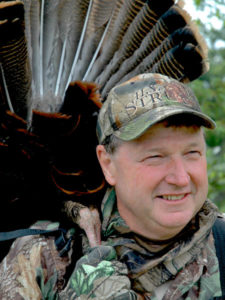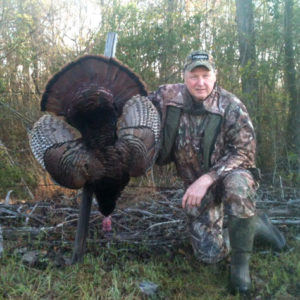“I maintain the attitude that there’s a turkey behind every tree and I’m not bashful about calling,” says World Champion Turkey caller Eddie Salter. “If I don’t get a response, I move to find a bird that’s workable.” A native of Alabama and a hunting veteran with experience across the country, Salter starts a day with stellar locating calls to crank up a gobbler and then sets up in the dark. “First, I put my ears to work,” says Salter. “Is the tom reacting to crow calling in the distance or other turkeys? If crows make a gobbler talk, then that’s what I give him until I’m in a good calling location. Also, a fresh barred owl “Who cooks for you?” often makes a gobbler sound off. If I hear other hens calling to the turkey or feel that it has hens, I let the gobbler reveal its mood and dictate the quantity and selection of calls.
Read the Mood
 If a tom gobbles a few seconds after you call, its saying ‘show me more’ whereas, if the turkey cuts off your tree calls and responds to you directly, really cut loose. When I find a turkey that is aggressive on the roost, I try to call more often and keep it fired up. The more aggressive I am, the more likely the bird will approach. Be patient after fly-down. We all love for a gobbler to pitch right at us, but that doesn’t often happen. Also, be prepared for a silent approach; if that gobbler has been hunted previously, it may come in without a sound.
If a tom gobbles a few seconds after you call, its saying ‘show me more’ whereas, if the turkey cuts off your tree calls and responds to you directly, really cut loose. When I find a turkey that is aggressive on the roost, I try to call more often and keep it fired up. The more aggressive I am, the more likely the bird will approach. Be patient after fly-down. We all love for a gobbler to pitch right at us, but that doesn’t often happen. Also, be prepared for a silent approach; if that gobbler has been hunted previously, it may come in without a sound.
Mid-Morning Strategies

Mid-morning is one of Salter’s favorite times to hunt because at that time of the day he believes turkeys either respond or they don’t. “It will usually happen in 15 minutes or it’s not going to happen,” he says, choosing to employ crow calls or very loud cutting on a box to trigger a response. “If I set up on a bird and make it gobble for 15-20 minutes and it hasn’t moved, my chances are very slim of killing that turkey. I might as well move and reset on that turkey or forget it and fire up another one. “Things happen, or they don’t,” says Salter.
Take a Nap
The heat of the day affects turkey activity, especially in the South where peak afternoon temperatures can reach 90 degrees. Salter sits out such times, biding his time until temperatures begin to cool in the late afternoon. “When the temperature starts dropping, you want to hit it hard,” says Salter. “Make a turkey gobble and get on it with that aggressive approach, especially in that early part of the season.”
Salter returns to an area where turkeys gobbled in the morning, sets up, calls, and remains patient. Often, toms are still searching for hens and showing patience in a good location avoids the possibility of spooking them while moving in swamps and thick terrain.
Last Chance

If Salter can’t get a bird to cooperate in late afternoon, he heads for known roosting areas as the day winds down. “I have cranked up a lot of birds in the afternoon and had a good hunt right before dark,” he says.
Southern turkeys often roost habitually in the same trees, which is a great benefit for beginning and ending each day. However, don’t hunt too close to the roost trees or this behavior may change. As long as a tom is gobbling and on the ground he’s vulnerable to calling. Don’t be shy, call aggressively, and hunt at peak alert. You may persuade a gobbler to deviate from his march to the roost, but you will only get one chance.”



















![The Best Deer Camp Chili [VIDEO] Deer Chili Ingredients, Tomatoes, Chili Spices](/wp-content/uploads/2015/10/Deer-Chili-Deer-Camp-Recipe-218x150.jpg)
![How to Call Elk Early in the Season [VIDEO]](/wp-content/uploads/2016/08/byers003-218x150.jpg)

![17[1]](/wp-content/uploads/2018/04/171.jpg)


![Idiots Disturb Hunter: How Would You Have Handled It? [VIDEO]](/wp-content/uploads/2015/10/DSC00110-e1474487693878-100x70.jpg)
![Albino Buck Shocked to Shed His Antlers [VIDEO]](/wp-content/uploads/2015/10/AlbinoDeer-100x70.jpg)